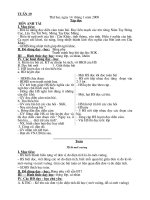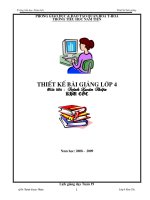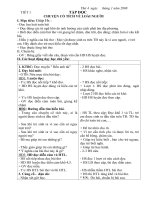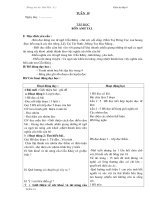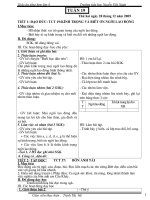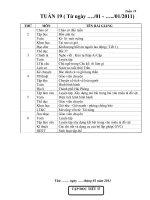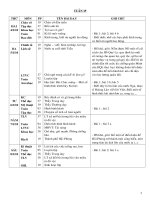giáo án lơp 4 tuần 19
Bạn đang xem bản rút gọn của tài liệu. Xem và tải ngay bản đầy đủ của tài liệu tại đây (128.56 KB, 9 trang )
<span class='text_page_counter'>(1)</span><div class='page_container' data-page=1>
Week 19 Period 71
Date of planning:
<b>UNIT 11: WHAT TIME IS IT?</b>
<b>LESSON 1(1,2)</b>
Class Date of teaching Absent students
4C
4D
………
………
<b>I.Aims</b>
<i><b>1.Knowledge</b></i>
<i><b>2.Skill </b></i>
<i><b>3.Attitude</b></i>
<b>At the end of the period, pupils will be able to: Use the words and </b>
phrases related to the topic Daily routines,ask and answer questions
about daily routines, using What time is it? - It’s + (time).
<b>Sentence patterns: What time is it? It’s + (time).</b>
<b>Vocabulary: time, o’clock, get up, go, go to school, breakfast, </b>
lunch, dinner
-Speaking,listening and Reading and writing .
-Pupils know about the topic of Daily routines
<i><b>II. Teaching</b></i>
<i><b>methods</b></i>
Work in pairs.individual,in groups...
<b>III. Teaching</b>
<b>aid</b>
<i>1.Teacher’s:student’s and teacher’s book,pictures, CD,cassette,.</i>
<i>2.Students’: books, notebooks, workbooks.</i>
<b>IV.PROCEDURES</b>
<b>1. Warm up: (5’) - To prepare pupils for this lesson, play a game</b>
<i>with them using the numbers five, ten, fifteen,</i>
<i>twenty, twenty-five, forty, forty-five, fifty and </i>
<i>fifty-five. Teacher says five, then choose a pupil to say</i>
the next number (i.e.ten). That pupil then chooses
another pupil say the next number
T- WC
<b>2.New lesson</b>
<b>(25’)</b>
<b>1. Look, listen and repeat: (14’)</b>
- We are going to learn to ask and answer quetion
about time.
- Ask students to look at the four pictures to
discuss the context in which the language is used.
- Ask pupils to answer some questions such as
Who are they? Where are they? And What are
they talking about?
<i>(In Picture a, Phong’s mother tells him to get up.</i>
<i>In Picture b, Phong asks his mother the time,</i>
<i>using What time is it? And his mother answers It’s</i>
<i>seven o’clock. In Picture c, Phong says he</i>
<i>doesn’t have to go to school on Sunday. In Picture</i>
<i>d, Phong’s mother tells him to get up for</i>
</div>
<span class='text_page_counter'>(2)</span><div class='page_container' data-page=2>
<i>breakfast.)</i>
- Play the recording a few times, ask students
listen and repeat. Do choral and individual
repetition, pointing to the characters speaking.
- Play the recording again and aks pupils listen and
repeat.
<i><b>*Language note: Seven o’clock is more common</b></i>
<i>in British English, while 7 a.m./p.m. is more</i>
<i>common in American English.</i>
<b>2. Point and say: (18’)</b>
- We are going to practise asking and answering
are used.
- Point to the first picture and ask pupils to say the
word seven.
- Ask pupils to look at the first picture and answer
the question: What time is it?
- Ask pupils to do chorally and individually.
- Ask pupils to practise in pairs.
- Repeat the same produre with the rest of the
pictures.
- Ask a few pairs to act out the dialogue in front of
the class.
<b>* Language note: </b>
<i><b>American English: British English:</b></i>
<i><b> seven fifteen a quarter pass seven</b></i>
<i>seven thirty half past seven</i>
<i>seven forty-five a quarter to eight</i>
<b>* Work in pairs. Ask your partners what time</b>
<b>it is.</b>
- We are going to ask and answer questions about
time.
- Ask pupils to work in pairs: one pupil asks What
time is it? And the other looks at the clock or their
wristwatch and answers
It’s + (time).
Whole class
Whole class
T- WC
T- WC
Whole class
Individually
Pairs/Group
Pairwork
Pairwork
T- WC
Pairwork
<b>3.Reinforcement</b>
<b>(5’)</b>
? What’s the content of the lesson? Individually
<b>4. Homelink: (2’) Learn by heart the new words and structures. </b>
Prepare for new lesson.
Whole class
<b>5.Comments:</b> ………
………
………
………
</div>
<span class='text_page_counter'>(3)</span><div class='page_container' data-page=3>
<i> Week 19 Period 72</i>
Date of planning:
<b>UNIT 11: WHAT TIME IS IT?</b>
<b>LESSON 1(3,4,5)</b>
Class Date of teaching Absent students
4C
4D
………
………
<b>I.Aims</b>
<i><b>1.Knowledge</b></i>
<i><b>2.Skill </b></i>
<i><b>3.Attitude</b></i>
<b>At the end of the period, pupils will be able to: Use the words and </b>
phrases related to the topic Daily routines,ask and answer questions
about daily routines, using What time is it? - It’s + (time).
<b>Sentence patterns: What time is it? It’s + (time).</b>
<b>Vocabulary: time, o’clock, get up, go, go to school, breakfast, </b>
lunch, dinner
-Speaking,listening and Reading and writing .
-Pupils know about the topic of Daily routines
<i><b>II. Teaching</b></i>
<i><b>methods</b></i>
Work in pairs.individual,in groups...
<b>III. Teaching</b>
<b>aid</b>
<i>1.Teacher’s:student’s and teacher’s book,pictures, CD,cassette,.</i>
<i>2.Students’: books, notebooks, workbooks.</i>
<b>IV.PROCEDURES</b>
<b>1. Warm up: (5’) - Spend a few minutes revising the previous</b>
lesson by getting pupils to play Bingo, using
the five times in Activity 2, and seven twenty,
seven thirty-five, seven forty and seven
fifty-five (nine diferent times in total). Then have
the class make sentences with the words that
were used in the game, using It’s + (time).
T- WC
<b>2.New lesson</b>
<b>(25’)</b>
<b>3. Listen and tick: (8’)</b>
- We are going to listen to three dialogues
about times and tick the correct pictures.
- Ask pupils to look at the pictures to identify
<i>the time (1a. Five o’clock. 1b. Six o’clock. 1c.</i>
<i>Seven o’clock. 2a. Seven fifteen. 2b. Seven</i>
<i>thirty. 2c. Seven forty-five. 3a. Eight fifteen. 3b.</i>
<i>Seven forty-five. 3c. Eight fifty.). Ask pupils to</i>
say the times aloud.
- Play the recording few times. Ask pupils
listen and tick the correct pictures.
- Ask pupils to swap their answers .
T- WC
Whole class
</div>
<span class='text_page_counter'>(4)</span><div class='page_container' data-page=4>
<b>Key: 1. b 2. b 3. a</b>
<b>Audio script:</b>
<i>1. Mother: Mai, it’s time for breakfast now.</i>
<i>Mai: What time is it, Mum?</i>
<i>Mother: It’s six o’clock.</i>
<i>Mai: OK, Mum.</i>
<i>2. Phong: What time is it Tony?</i>
<i>Tony: It’s seven thirty.</i>
<i>Phong: Seven thirteen or seven thirty?</i>
<i>Mai: Seven thirty.</i>
<i>Phong: Thank you.</i>
<i>Tony: You are welcome.</i>
<i>3. Nam: What time is it, Mai?</i>
<i>Mai: It’s eight o’clock.</i>
<i>Nam: Eight fifteen or eight fifty?</i>
<i>Mai: Eight fifteen.</i>
<i>Nam: Thank you.</i>
<i>Mai: You’re welcome.</i>
<b>4. Look and write: (12’)</b>
- We are going to write the answers to the
<i>question What time is it? with the picture cues.</i>
- Ask pupils to look at the clock and the answer
in 1.
- Ask pupil to look at the other clocks and use
the appropriate words to complete the answers.
- Ask pupils to work in pairs.
- Ask pupils to do the tast independently.
- Ask pupils to swap their answers.
- If there is inough time, invite some pairs to
act out the dialogues.
<b>5. Let’s sing: (12’)</b>
<i>- We are going to sing the song What time is</i>
<i>it? </i>
- Ask pupils to read each line of the lyrics.
Check comprehension.
- Play the recording all the way through. Ask
pupils to do choral and individual repetitionof
the song line by line.
- Ask a group of four to the front of the class.
One group sings the questions, and the other
sings the answers.
- Ask the class to sing the song again and clap
your hands to reinforce the activity.
T- WC
Whole class
Whole class
Pairwork
Individually
Pairwork
T- WC
T- WC
Whole class
Whole class/
Individually
Groupwork
</div>
<span class='text_page_counter'>(5)</span><div class='page_container' data-page=5>
<b>3.Reinforcement</b>
<b>(5’)</b>
? What’s the content of the lesson? Individually
<b>4. Homelink: (2’) Learn by heart the new words and structures. </b>
Prepare for new lesson.
Whole class
<b>5.Comments:</b> ………
………
………
………
Teacher
Week 19 Period 73
Date of planning:
<b>UNIT 11: WHAT TIME IS IT?</b>
<b>LESSON 2 (1,2,3)</b>
Class Date of teaching Absent students
4C
4D
………
………
<b>I.Aims</b>
<i><b>1.Knowledge</b></i>
<i><b>2.Skill </b></i>
<i><b>3.Attitude</b></i>
At the end of the period, pupils will be able to: Ask and answer
questions about daily routines, using What time do you ...?
I ... at + (time).
<b>Sentence patterns: What time do you ...? I ... at + (time)</b>
<b>Vocabulary: have breakfast, have lunch, have dinner, go to bed</b>
Speaking,listening and Reading and writing .
-Pupils know about the topic of daily routines
<b>II. Teaching</b>
<b>methods</b>
Work in pairs.individual,in groups...
<b>III. Teaching</b>
<b>aids</b>
<i>1.Teacher’s:student’s and teacher’s book,pictures, CD,cassette,.</i>
<i>2.Students’: books, notebooks, workbooks.</i>
<b>IV.PROCEDURES</b>
<b>1. Warm up: (5’) Spend a few minutes revising the previous lesson</b>
by calling some pupils to the front of the class to
<i>sing the song What time is it? The rest of the class</i>
to sing together, clapping hands.
Groupwork
<b>2.New lesson</b>
<b>(25’)</b>
<b>1. Look, listen and repeat: (10’)</b>
- We are going to learn to ask and answer
questions about daily routines.
- Ask pupils to look at the four pictures to
understand the context in which the language is
used.
</div>
<span class='text_page_counter'>(6)</span><div class='page_container' data-page=6>
<i>- Ask pupils to listen. In the first picture, Tony</i>
<i>asks Linda What time do you get up? And Linda</i>
<i>answers Six o’clock. In the second picture, Linda</i>
<i>and Tony ask and answer about the time now,</i>
<i>using What time is it now? And Seven fifteen. In</i>
<i>the last two pictures, Linda says that they are late</i>
<i>for school, so they start running. </i>
- Play the recording more than once, ask students
listen and repeat. Do choral and individual
repetition, pointing to the characters speaking.
- Play the recording again and aks pupils listen and
repeat.
<b>*Language note: </b>
<i>We use o’clock to refer to an exact hour (i.e. when</i>
<i>the minute hand strickes 12).</i>
<b>2. Point and say: (14’)</b>
- We are going to practise asking and answering
questions about the time for daily activities.
- Ask pupils to look at the pictures and teach the
<i>prases :get up, have breakfast, have dinner and go</i>
<i>to bed.</i>
- Point to the first picture and ask one pupil to ask
<i>What time do you get up? and another to answer I</i>
<i>get up at six o’clock.</i>
- Ask pupils to do choral and individual repetition.
Repeat the same procedure with the rest of the
pictures.
- Ask pupils to work in pairs, pointing to the
characters speaking and to role-play the dialogue.
<b>3. Let’s talk: (8’)</b>
- We are going to revise what we have learn in
Lesson 1 and 2.
- Ask pupils to work in pairs: one pupil asks the
<i>questions What time is it? and What time do you ...</i>
<i>? and the other gives the answers. Then they swap</i>
roles.
- Call on a few pairs to act out the dialogue in
front of the class.
- If there is enough time, ask some pupils to talk
<i>about their daily routines, e.g. I get up at six</i>
<i>o’clock. I have breakfast at six thirty and I go to</i>
<i>school at seven o’clock, etc.</i>
Whole class
Individually
Whole class
Whole class
T- WC
Whole class
Individually
……
T- WC/
Individually
Pairwork
Whole class
Individually
Pairwork
T- WC
Pairwork
</div>
<span class='text_page_counter'>(7)</span><div class='page_container' data-page=7>
<b>3.Reinforcement</b>
<b>(5’)</b>
? What’s the content of the lesson? Individually
<b>4. Homelink: (2’) Learn by heart the new words and structures. </b>
Prepare for new lesson.
Whole class
<b>5.Comments:</b> ………
………
………
………
Teacher
Week 19 Period 74
Date of planning:
<b>UNIT 11: WHAT TIME IS IT?</b>
<b>LESSON 2(4,5,6)</b>
Class Date of teaching Absent students
4C
4D
………
………
<b>I.Aims</b>
<i><b>1.Knowledge</b></i>
<i><b>2.Skill </b></i>
<i><b>3.Attitude</b></i>
At the end of the period, pupils will be able to: Ask and answer
questions about daily routines, using What time do you ...?
I ... at + (time).
<b>Sentence patterns: What time do you ...? I ... at + (time)</b>
<b>Vocabulary: have breakfast, have lunch, have dinner, go to bed</b>
Speaking,listening and Reading and writing .
-Pupils know about the topic of daily routines
<b>II. Teaching</b>
<b>methods</b>
Work in pairs.individual,in groups...
<b>III. Teaching</b>
<b>aids</b>
<i>1.Teacher’s:student’s and teacher’s book,pictures, CD,cassette,.</i>
<i>2.Students’: books, notebooks, workbooks.</i>
<b>IV.PROCEDURES</b>
<b>1. Warm up: (5’) Spend a few minutes revising the previous lesson</b>
by asking some pupils to go to the front of the
class and talk about the daily routines.
Individually
<b>2.New lesson</b>
<b>(25’)</b>
<b>4. Listen and draw the time: (9’)</b>
- We are going to listen to Tom’s daily routine and
draw the hands of the clocks.
- Focus their attention on the pictures and discuss
with them what Tom does every day.Then tell
them to look at the clock in each picture and
explain that they have to draw the hands to show
</div>
<span class='text_page_counter'>(8)</span><div class='page_container' data-page=8>
the time.Check understanding.
- Play the recording more than once, ask pupils
listen to recording and draw the times.
- Ask pupils swap their answers. Check.
<b>Key:</b>
<i>b – 7.30; c – 8.15; d – 8.00; e – 9.00</i>
<b>Audio script:</b>
<i>Hi. My name’s Tom. I’m a pupils at Nguyen Du</i>
<i>Primary School. Every day, I get up at seven</i>
<i>o’clock. I have breakfast at 7.30. I go to school</i>
<i>from 9 a.m. to 3 p.m. I go home at 3.45. In the</i>
<i>evening. I have dinner at seven. I watch TV at</i>
<i>eight and go to bed at nine.</i>
<b>5. Draw and write the time: (15’)</b>
- We are going to draw the time and write about
their daily routines.
- First, ask pupils to look at the questions and
identify what daily routines they are going to write
about. Then have pupil draw the hands of the
clocks to show the times they usually do these
activities. Finally, ask pupils to write the answers
to the questions, using the clocks they have just
drawn.
- Ask pupils to do the tesk independently.
- Ask pupils to swap their answers. Check.
<b>6. Let’s play: (8’)</b>
- We are going to play the game Pass the secret!
Follow the rocedure in Games in Introduction.
- Divide the lass into groups of six or seven. Ask
pupils to sit in circles. Pupil 1 in each circle
<i>whispers a sentence to Pupil 2, e.g. I get up at six</i>
<i>o’clock. Then Pupil 2 whispers the same sentence</i>
<i>to Pupil 3. Continue until the last pupil has heard</i>
the sentence and said it aloud. The group that says
the sentence correctly in the shortest time will win
the game.
- Call on one group to act out the game in front of
the class.
Whole class
Pairwork
T- WC
T- WC
Individually
Pairwork
T- WC
Groupwork
Groupwork
<b>3.Reinforcement</b>
<b>(5’)</b>
? What’s the content of the lesson? Individually
<b>4. Homelink: (2’) Learn by heart the new words and structures. </b>
Prepare for new lesson.
Whole class
</div>
<span class='text_page_counter'>(9)</span><div class='page_container' data-page=9>
………
………
………
</div>
<!--links-->

